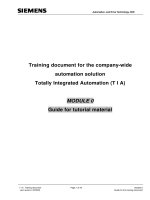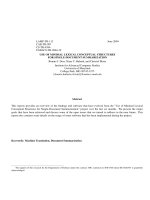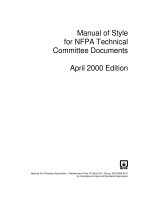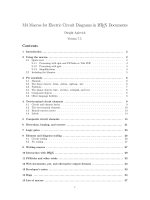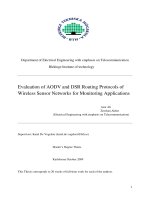CPY document
Bạn đang xem bản rút gọn của tài liệu. Xem và tải ngay bản đầy đủ của tài liệu tại đây (4.05 MB, 121 trang )
THE ALGEBRA OF PROBABLE INFERENCE
The Algebra of
Probable Inference
by Richard T. Cox
PROFESSOR OF PHYSICS
THE JOHNS HOPKINS UNIVERSITY
BAl TIMORE:
The Johns Hopkins Press
www.pdfgrip.com
\
.~
(
\c.j.
.\~/
, ~-"
..:\ -
(£ 1961 by The Johns Hopkis Press, Baltimore 18, Md.
Distributed in Great Britain by Oxford University Press, London
Printed in the United States of America by Horn-Shafer Co., Baltimore
Library of Congress Catalog Card Number: 61-8039
www.pdfgrip.com
to my wífe Shelby
www.pdfgrip.com
Preface
This essay had its beginning in an article of mine published in
1946 in the American Journal of Physics. The axioms of probabilty were formulated there and its rules were derived from
them by Boolean algebra, as in the first part of this book. The
relation between expectation and experience was described, although very scantily, as in the third part. For some years past,
as I had time, I have developed further the suggestions made in
that article. I am grateful for a leave of absence from my duties
at the Johns Hopkis University, which has enabled me to bring
them to such completion as they have here.
Meanwhile a transformation has taken place in the concept of
entropy. In its earlier meaning it was restricted to thermo-
dynamics and statistical mechanics, but now, in the theory of
communication developed by C. E. Shannon and in subsequent
work by other authors, it has become an important concept in
the theory of probability. The second part of the present essay
is concerned with entropy in this sense. Indeed I have proposed
an even broader definition, on which the resources of Boolean
algebra can be more strongly brought to bear. At the end of the
essay, I have ventured some comments on Hume's criticism of
induction.
Writing a preface gives a welcome opportunity to thank my
colleagues for their interest in my work, especially Dr. Albert L.
Hammond, of the Johns Hopkins Department of Philosophy, who
was good enough to read some of the manuscript, and Dr. Theodore H. Berlin, now at the Rockefeller Institute in New York but
recently with the
Department of Physics at Johns Hopkins. For
help with the manuscript it is a pleasure to thank Mrs. Mary B.
Vll
www.pdfgrip.com
Rowe, whose kindness and skill as a typist and linguist have
aided members of the faculty and graduate students for twentyfive years.
I have tried to indicate my obligations to other writers in the
notes at the end of the book. Even without any such indication,
readers familiar with A Treatise on Probability by the late J. M.
Keynes would have no trouble in seeing how much I am indebted
to that work. It must have been thirty years or so ago that I first
read it, for it was almost my earliest reading in the theory of probability, but nothing on the subject that I have read since has given
me more enjoyment or made a stronger impression on my mind.
The Johns Hopkins University
BALTIMORE, MARYLAND
Vlll
www.pdfgrip.com
R. T. C.
Contents
vii
Preface
1
i. Probability
1. Axioms of Probable Inference
1
2. The Algebra of Propositions
4
3. The Conjunctive Inference
4. The Contradictory Inference
5. The Disjunctive Inference
6. A Remark on Measurement
12
18
24
29
35
II. Entropy
7. Entropy as Diversity and Uncertainty
and the Measure of Information
8. Entropy and Probabilty
9. Systems of Propositions
10. The Entropy of Systems
11. Entropy and Relevance
12. A Remark on Chance
ix
www.pdfgrip.com
35
40
48
53
58
65
x
CONTENTS
69
III. Expectation
13. Expectations and Deviations
14. The Expectation of Numbers
15. The Ensemble of Instances
69
74
79
17. Expectation and Experience
82
87
18. A Remark on Induction
91
16. The Rule of Succession
Notes
99
Index
109
www.pdfgrip.com
THE ALGEBRA OF PROBABLE INFERENCE
www.pdfgrip.com
I
Proba bility
1. Axioms of Probable Inferenc~ 1
A probable inference, in this essay as in common usage, is one
entitled on the evidence to partial assent. Everyone gives fuller
assent to some such inferences than to others and thereby distinguishes degrees of probability. Hence it is natural to suppose
that, under some conditions at least, probabilities are measurable.
Measurement, however, is always to some extent imposed upon
what is measured and foreign to it. For example, the pitch of a
stairway may be measured as an angle, in degrees, or it may be
reckoned by the rise and run, the ratio of the height of a step to its
width. Either way the stairs are equally steep but the measurements differ because the choice of scale is arbitrary. It is there-
fore reasonable to leave the measurement of probability for discussion in later chapters and consider first what principles of
probable inerence wil hold however probability is measured.
Such principles, if there are any, wil play in the theory of
probable inference a part like that of carnots principle in ther-
modynamics, which holds for all possible scales of temperature,
or like the parts played in mechanics by the equations of Lagrange
and Hamilton, which have the same form no matter what system
of coordinates is used in the description of motion.
It has sometimes been doubted that there are principles valid
over the whole field of probable inference. Thus Venn wrote in
his Logic of Chance: 2
1
www.pdfgrip.com
,
r
PROBABILITY
2
"In every case in which we extend our inferences by Induction or Analogy, or depend upon the witness of others, or trust
to our own memory of the past, or come to a conclusion through
conflicting arguments, or even make a long and complicated
deduction by mathematics or logic, we have a result of which
we can scarcely feel as certain as of the premises from which it
was obtained. In all these cases then we are conscious of varying quantities of belief, but are the laws according to which the
belief is produced and varied the same? If they cannot be re-
duced to one harmonious scheme, if in fact they can at best
be brought to nothing but a number of different schemes, each
with its own body of laws and rules, then it is vain to endeavour
to force them into one science."
In this passage, the first of three sentences distinguishes types
of inference which common usage calls probable, the second asks
whether inferences of these different kinds are subject to the
same laws and the third implies that they are not. Nevertheless,
if we look for them, we can find likenesses among these examples
and likenesses also between these and others which would be
accepted as proper examples of probability by all the schools of
thought on the subject. Venn himself belonged to the school of
authors who define probabilty in statistical terms and restrict its
meaning to examples in which it can be so defined.3 By their
definition, they estimate the probability that an event wil occur
under given circumstances from the relative frequencies with
which it has occurred and failed to occur in past instances of the
same circumstances. Every instance in which it has occurred
strengthens the argument that it wil occur in a new instance and
every contrary instance strengthens the contrary argument.
Thus, whenever they estimate a probability in the restricted
sense their definition allows and the way their theory prescribes,
they "come to a conclusion through conflcting arguments," as do
the advocates of other definitions and theories. The argument,
moreover, which makes one inerence more probable makes the
contradictory inference less probable and thus the two probabilities stand in a mutual relation. In this all schools can agree and
www.pdfgrip.com
I
i
3
PROBABILITY
it may be taken as an axiom on any definition of probabilty that:
The probabilty of an inference on given evidence determines
the probabilty of its contradictory
on the same evidence. (1.)
Continuing with Venn's list of varieties of probable inference,
let us consider the probability of the right result in "a long and
complicated deduction in mathematics" and compare it with the
probability of a long run of luck at cards or dice, a classical example in the theory of probabilty. In any game of chance, a
long run of luck is, of course, less probable than a short one, because the run may be broken by a mischance at any single toss of a
die or drawing of a card. Similarly, in a commonplace example
of mathematical deduction, a long bank statement is less likely
to be right at the end than a short one, because a mistake in any
single addition or subtraction wil throw it out of balance.
Clearly we are concerned here with one principle in two examples.
A mathematical deduction involving more varied operations in its
successive steps or a chain of reasoning in logic would provide
only another example of the same principle.
The uncertainties of testimony and memory, also cited by
Venn, come under this principle as w'ell. Consider, for example,
the probabilty of the assertion, made by Sir John Maundeville in
his Travels, that Noah's Ark may stil be seen on a clear day, resting where it was left by the receding waters of the Flood, on the
top of Mount Ararat. For this assertion to be probable on Sir
John's testimony, it must first of all be probable that he made it
from his recollection rather than his
fancy. Then, on the assump-
tion that he wrote as he remembered what he saw or heard told,
it must be probable also that his memory could be trusted against
a lapse such as might have occurred during the long years after
he left the region of Mount Ararat and before he found in his
writing a solace from his "rheumatic gouts" and his "miserable
rest." Finally, on the assumption that his testimony was honest
and his memory sound, it must be probable that he or those on
whom he depended could be sure that they had truly seen Noah's
www.pdfgrip.com
4
PROBABILITY
Ark, a matter made somewhat doubtful by his other statement
that the mountain is seven miles high and has been ascended only
once since the Flood.
Every assertion which, like this one, involves the transmission
of knowledge by a witness or its retention in the memory is, on
this account, a conjunction of two or more assertions, each of
which contributes to the uncertainty of the joint assertion. For
this reason, it comes under the same principle which we saw in-
volved in the probability of a run of luck at cards and which can
be stated in the following axiom:
The probabilty on given evidence that both of two inferences are true is determined by their separate probabilities,
one on the given evidence, the other on this evidence with the
additional assumption that the first inference is true. (1.i)
Thus the uncertainties of testimony and memory, of long and
complicated deductions and conflcting arguments-all the
specific examples in Venn's list-have traits in common with one
another and with the classical examples provided by games of
chance.
The more general subjects of induction and analogy, also men-
tioned in the quotation from Venn, must be reserved for discussion in later chapters, but the examples already considered may
serve to launch an argument that all kinds of probable inference
can be "reduced to one harmonious scheme."4
For this reduction, the argument wil require only the two
axioms just given, when they are implemented by the logical rules
of Boolean algebra.6
2. The Algebra of Propositions
Ordinary algebra is the algebra of quantities. In our use of it
here, quantities will be denoted by italic letters, as a, b, A, B.
Boolean algebra is the algebra, among other things, of propositions. Propositions wil be denoted here by small boldface let-
www.pdfgrip.com
5
PROBABILITY
ters, as a, b, c. The meaning of a proposition in Boolean algebra
corresponds to the value of a quantity in ordinary algebra. For
example, just as, in ordinary algebra, a certain quantity may have
a constant value throughout a given calculation or a variable one,
so, in Boolean algebra, a proposition may have a fixed meaning
throughout a given discourse or its meaning may vary according
to the context within the discourse. Thus "Socrates is a man" is
a familiar proposition of constant meaning in logical discourse,
whereas the proposition, "I agree with all that the previous
speaker has said," has a meaning variable according to the
occasion. For another example of the same correspondence, just
as an ordinary algebraic equation, such as
(a + b)c = ac + bc,
states that two quantities, although different in form, are nevertheless the same in value, so a Boolean equation states that two
propositions of different form are the same in meaning.
Of the signs used for operations peculiar to Boolean algebra, we
shall need only three, "', . and V, which denote respectively not,
and and or.6 Thus the proposition not a, called the contradictory
of a, is denoted by "'a. The relation between a and "'a is a
mutual one, either being the other's contradictory. To deny "'a
is therefore to affm a, so that
"'''a = a.
The proposition a and b, called the conjunction of a and b, is denoted by a. b. The order of propositions in the conjunction is the
order in which they are stated. In ordinary speech and writing,
if propositions describe events, it is customary to state them in the
chronological order in which the events take place. So the nur-
sery jingle runs, "Tuesday we iron and Wednesday we mend."
It would have the same meaning, however, if it ran, "Wednesday
we mend and Tuesday we iron." In this example, therefore, and
also in general,
b.a = a.b.
www.pdfgrip.com
6
PROBABILITY
Similarly the expression a.a means only that the proposition a is
stated twice and not that an event described by a has occurred
twice. Rhetorically it is more emphatic than a, but logically it
is the same. Thus
a.a = a.
Parentheses are used in Boolean as in ordinary algebra to indicate that the expression they enclose is to be treated as a single
entity in respect to an operation with an expression outside.
They designate an order of operations, in that any operations
indicated by signs in the enclosed expression are to be performed
before those indicated by signs outside. The parentheses are
unnecessary if the order of operations is immateriaL. Thus
(a. b). c denotes the proposition obtained by first conjoining a
with b and then conjoining a. b with c, whereas a. (b. c) denotes
the proposition obtained by first conjoining b with c and then
conjoining a with b. c, but the propositions obtained in these two
sequences of operations have the same meaning and the parentheses may therefore be omitted. Accordingly,
(a.b).c = a.(b.c) = a.b.c.
The proposition a or b, called the disjunction of a and b, is denoted by a V b. It is to be understood that or is used here in the
sense intended by the notice, "Anyone hunting or fishing on this
land wil be prosecuted," which is meant to include persons who
both hunt and fish along with those who engage in only one of
these activities. This is to be distinguished from the sense in-
tended by the item, "coffee or tea," on a bil of fare, which is
meant to offer the patron either beverage but not both. Thus V
has the meaning which the form and/or is sometimes used to
express.
Let us now consider expressions involving more than one of the
signs, "', . and V. In this consideration it should be kept in mind
that ",a is not some particular proposition meant to contradict a
item by item. For example, if a is the proposition, "The dog is
www.pdfgrip.com
7
PROBABILITY
small, smooth-coated, bob-tailed and white all over except for
black ears," rva is not the proposition, "The dog is large, wire-
haired, long-tailed and black all over except for white ears." To
assert rva means nothing more than to say that a is false at least
in some part. If a is a conjunction of several propositions, to
assert rva is not to say that they are all false but only to say that
at least one of them is false. Thus we see that
rv(a.b) = rva V rvb.
From this equation and the equality of rv rva with a, there is
derived a remarkable feature of Boolean algebra, which has no
counterpart in ordinary algebra. This characteristic is a duality
according to which the exchange of the signs, . and V, in any
equation of propositions transforms the equation into another
one equally valid.7 For example, exchanging the signs in this
equation itself, we obtain
rv(a V b) = rva. rvb,
which is proved as follows:
a vb = rvrva V rvrvb = rv(rva.rvb).
Hence
rv(avb) = rvrv(rva.rvb) = rva.rvb.
From the duality in this instance and the mutual relation of a
and rva, the duality in other instances follows by symmetry. We
have, accordingly, from the equations just preceding,
b V a = a V b,
aVa=a
and
(a V b) V c = a V (b V c) = a V b V c.
The propositions (a V b).c and a V (b.c) are not equal. For,
if a is true and c false, the first of them is false but the second is
www.pdfgrip.com
T
~::
8
PROBABILITY
true. Therefore the form a V b.c is ambiguous. In verbal ex-
pressions the ambiguity is usually prevented by the meaning of
the words. Thus, in a weather forecast, "rain or snow and high
winds," would be understood to mean "(rain or snow) and high
winds," whereas "snow or rising temperature and rain" would
mean "snow or (rising temperature and rain)." In symbolic expressions, on the other hand, the meaning is not given and parentheses are therefore necessary.
When we assert (a V b).c, we mean that at least one of the
propositions, a and b, is true, but c is true in any case. This is
the same as to say that at least one of the propositions, a.c and
b. c, is true and thus
(a V b).c = (a.
c) V (b.
c).
The dual of this equation is
(a.
b) V c = (a V c).(b V c).
If, in either of these equations, we let c be equal to b and substitute b for its equivalent, b. b in the first equation or b V bin
the second, we find that
(a V b).b = (a.
b) vb.
In this equation, the exchange of the signs, . and V, has only the
effect of transposing the members; the equation is dual to itself.
Each of the propositions, (a V b). b and (a. b) V b, is, indeed,
equal simply to b. Thus to say, "He is a fool or a knave and he is
a knave," or "He is a fool and a knave or he is a knave," sounds
perhaps more uncharitable than to say simply, "He is a knave,"
but the meaning is the same.
In ordinary algebra, if the value of one quantity depends on the
values of one or more other quantities, the first is called a function
of the others. Similarly, in Boolean algebra, we may call a
proposition a function of one or more other propositions if its
meaning depends on theirs. For example, a V b is a Boolean
function of the propositions a and b as a + b is an ordinary function of the quantities a and b.
www.pdfgrip.com
9
PROBABILITY
It may be remarked that the operations of Boolean algebra
generate functions of infinitely less variety than is found among
the functions of ordinary algebra. In ordinary algebra, because
a X a = a2, a X a2 = a3, . . . and a + a = 2a, a + 2a = 3a, . . . ,
there is no end to the functions of a single variable which can be
generated by repeated multiplications and additions. By contrast, in Boolean algebra, a.a and a Va are both equal simply to
a, and thus the signs, . and V, when used with a single proposition, generate no functions.
The only Boolean functions of a single proposition are itself and
its contradictory. In form there are more; thus a V rva has the
form of a function of a, but it is a function only in the trivial sense
in which x - x and x/x are functions of x. In Boolean algebra,
a V rva plays the part of a constant proposition, because it is a
truism and remains a truism through all changes in the meaning
of a. To assert a truism in conjunction with a proposition is no
more than to assert the proposition alone. Thus
(a V rva). b = b
for every meaning of a or b. On the other hand, to assert a
truism in disjunction with a proposition is only to assert the
truism; a V rva V b, being true for every meaning of a or b, is itself
a truism, so that
a V rva V b = a V rva.
Each of these equations has its dual and thus
(a. rva) V b = b
and
a. rva. b = a. rva.
The proposition a. rva is an absurdity for every meaning of a and
is thus another constant proposition. These two constant propositions, the truism and the absurdity, are mutually contradictory.
It wil be convenient for future reference to have the following
collection of the equations of this chapter.
www.pdfgrip.com
10
PROBABILITY
"'''a = a,
a.a = a,
b.a = a.b,
"'(a.b) = "'a V ",b,
(2.1)
(2.2 I)
a V a = a,
(2.2 II)
(2.3 I)
b V a = a V b,
(2.3 II)
(2.4 I)
"'(a V b) = "'a. ",b,
(2.4 II)
(a.b).c = a.(b.c) = a.b.c,
(a V b) V c = a V (b V c)
= a V b V c, (2.5 II)
(2.5 I)
(a V b).c = (a.c) V (b.c),
(a.
b) V c = (a V c).(b V c),
(2.6 I)
(a Vb).b = b,
(a V "'a).b = b,
(2.7 I)
(2.8 I)
a V ",a V b = a V "'a,
(2.6 II)
(a. b) vb = b,
(a. ",a) V b = b,
(2.7 II)
(2.8 II)
a. "'a. b = a. "'a.
(2.9 I)
(2.9 II)
Each of these equations after the first is dual to the equation on
the same line in the other column, from which it can be obtained
by the exchange of the signs, . and V. In the preceding discussion, the equations on the left were taken as axioms and those on
the right were derived from them and the first equation. If, in-
stead, the equations on the right had been taken as axioms, those
on the left would have been their consequences. Indeed any set
which includes the first equation and one from each pair on the
same line wil serve as axioms for the derivation of the others.
More equations can be derived from these by mathematical
induction. For example, it can be show n, by an induction from
Eq. (2.4 I), that
"'(a1.a2'" ..am) = "'a1 V "'a2 V.. .V "'am,
(2.10 I)
w here ai, a2, . . . am are any propositions.
We first assume provisionally, for the sake of the induction,
that this equation holds when m is some number k and thence
www.pdfgrip.com
11
PROBABILITY
prove that it holds also when m is k + 1 and consequently when
it is any number greater than k.
Replacing 3 in Eq. (2.4 I) by 31'32'.. .'3k and b by 3k+ll we
have
"'((31'32'" ..3k).3k+1J = "'(31'32'" ..3k) V"'3k+1.
By the provisional assumption just made,
"'(31'32'" ..3k) = "'31 V "'32 V... V "'3k,
and thus
"'((31'82'" ,'3k).3k+1J = ("'31 V "'32 V... V "'3k) V "'3k+!.
Therefore, by Eqs. (2.5 I) and (2.5 II)
"'(31'32'" ..3k.3k+1) = "'31 V "'32 V ... V "'3k V "'3k+1'
Thus Eq. (2.10 I) is proved when m is k + 1 if it is true when m
is k. By Eq. (2.4 I), it is true when m is 2. Hence it is proved
when m is 3 and thence when m is 4 and when it is any number,
however great.
By exchanging the signs, . and V, in Eq. (2.10 I), we obtain
its dual, also valid:
'" (31 V 32 V . . . V 3m) = "'31' "'32'. . .' "'3m,
(2.10 II)
an equation which can also be derived by mathematical induction
from Eq. (2.4 II).
A mathematical induction from Eq. (2.6 I) gives:
(31 V 32 V... V 3m).b = (31.b) V (32.b) V... V (3m'
b).
(2.11 I)
By an exchange of signs in this equation or an induction from
Eq. (2.6 II), we obtain
(31'32'" ,'3m) vb = (31 V b).
(32 V b)... ,'(3m V b). (2.11 II)
www.pdfgrip.com
12
PROBABILITY
3. The Conjunctive Inference
Every conjecture is based on some hypothesis, which may consist wholly of actual evidence or may include assumptions made
for the argument's sake. Let h denote an hypothesis and i a
ì;t!-
proposition reasonably entitled to partial assent as an inference
1,'
from it. The probability is a measure of this assent, determined,
more or less precisely, by the two propositions, i and h. It is
therefore a numerical function of propositions, in contrast with
the functions considered in the preceding chapter, which, being
themselves propositions, may be called propositional functions of
propositions. (Readers familiar with vector analysis may be
reminded of the distinction between scalar and vector functions
of vectors.) 8
Let us denote the probability of the inference i on the hypothesis h by the symbol i I h, which wil be enclosed in parentheses
when it is a term or factor in a more complicated expression.9
The choice of a scale on which probabilties are to be reckoned is
stil undecided at this stage of our consideration. If i I h is a
measure of the assent to which the inference i is reasonably entitled on the hypothesis h, it meets all tne requirements of a
probability which our discussion thus far has imposed. But, if
i I h is such a measure, then so also is an arbitrary function of
i I h, such as 100 (i I h), (i I h)2 or In (i I h). The choice among
the different possible scales of probability is made by conventions
which wil be considered later.
The probability on the hypothesis h of the inference formed by
conjoining the two inferences i and j is represented, in the notation
just given, by i. j I h. By the axiom (1.ii), this probability is a
function of the two probabilities: i I h, the probability of the first
inference on the original hypothesis, and j I h.i, the probability
of the second inference on the hypothesis formed by conjoining
the original hypothesis with the first inference. Callng this
function F, we have:
www.pdfgrip.com
13
PROBABILITY
¡.j I h = F((¡ I h), (j I h'¡)J.
(3.1)
Since the probabilties are all numbers, F is a numerical function
of two numerical variables.
The form of the function F is in part arbitrary, but it can not
be entirely so, because the equation must be consistent with
Boolean algebra. Let us see what restriction is placed on the
form of F by the Boolean equation
(a.b).c = a.(b.c) = a.b.c.
If we let
h = a, ¡ = b, j = c.d,
so that
¡.j = b. (c.d) = b.c.d,
Eq. (3.1) becomes
b.c.d I a = F((b I a), (c.d I a. b)J = F(x, (c.d I a. b)J,
where, for brevity, x has been written for b I a. Also, if we now
let
h = a. b, ¡ = c, j = d,
so that
h.¡ = (a.b).c = a.b.c,
Eq. (3.1) becomes
c.d I a.b = F((c I a.b), (d I a.b.c)J = F(y, z),
where y has been written for cia. band z for d I a. b.c. Hence,
by substitution in the expression just obtained for b.c.d I a, we
find,
b.c.d I a = F(x, F(y, z)J.
Similarly, if, in Eq. (3.1), we let
h = a, ¡ = b.c, j = d,
www.pdfgrip.com
(3.2)
14
PROBABILITY
we find
b.c.d I a = F((b.c I a), zJ,
and, if we now let
h = a, ¡ = b, j = c,
we have
b.c I a = F(x, y),
so that
b.c.d I a = FrF(x, y), zJ.
Equating this expression for b.c.d I a with that given by Eq.
(3.2), we have
F(x, F(y, z)J = F(F(x, y), zJ,
(3.3)
as a functional equation to be satisfied by the function F.10
Let F be assumed differentiable and let àF(u, v)/àu be denoted
by F1(u, v) and àF(u, v)/àv by F2(u, v). Then, by differentiating
this equation with respect to x and y, we obtain the two equations,
F1(x, F(y, z)J = F1(F(x, y), Z)F1(X, y),
F2(x, F(y, Z))F1(y, z) = F1(F(x, y), zJF2(x, y).
Eliminating F1(F(x, y), zJ between these equations gives a result
which may be written in either of the two forms:
G(x, F(y, Z))F1(y, z) = G(x, y),
(3.4)
G(x, F(y, Z))F2(y, z) = G(x, y)G(y, z),
(3.5)
where G(u, v) denotes F2(u, v)/F1(u, v).
Differentiating the first of these equations with respect to z and
the second with respect to y, we obtain equal expressions on the
left and so find
à(G(x, y)G(y, z)J/ày = O.
www.pdfgrip.com
15
PROBABILITY
Thus G must be such a function as not to involve y in the product
G(x, y)G(y, z). The most general function which satisfies this
restriction is given by
G(u, v) = aH(u)/H(v),
where a is an arbitrary constant and H is an arbitrary function of
a single variable.
Substituting this expression for G in Eqs. (3.4) and (3.5), we
obtain
F1(y, z) = H(F(y, z)JjH(y),
F2(y, z) = aH(F(y, z)JjH(z).
Therefore, since dF(y, z) = F1(y, z) dy + F2(y, z) dz, we find
dF(y,z) = ~ + a~
H(F(y, z)J H(y) H(z) .
Integrating, we obtain
CP(F(y, z)J = P(y)(P(z)Ja,
(3.6)
where C is a constant of integration and P is a function of a single
variable, defined by the equation,
In P(u) = H(u) .
f du
Because H is an arbitrary function, so also is P.
Equation (3.6) holds for arbitrary values of y and z and hence
for arbitrary variables of which P and F may be functions. If we
take the function P of both members of Eq. (3.3), we obtain an
equation from which F may be eliminated by successive substitu-
tions of P(F) as given by Eq. (3.6). The result is to show that
a = 1. Thus Eq. (3.6) becomes
CP(F(y, z)J = P(y)P(z).
If, in this equation, we let y be ¡ I hand z bej I h.¡, then, by Eq.
(3.1), F(y, z) = i- I h. Thus
www.pdfgrip.com
16
PROBABILITY
CP(i.j I h) = P(i I h)P(j I h.i).
The function P, being arbitrary, may be given any convenient
form. Indeed, if we so choose, we may leave its form undetermined for, as was remarked earlier in this chapter, if i I h measures
probability, so also does an arbitrary function of i I h. We could
give the name of probability to P(i I h) rather than to i I hand
never be concerned with the relation between the two quantities,
because we should never have occasion to use i I h except in the
function P(i I h). In effect we should merely be adopting a dif-
ferent symbol of probability. Instead, let us retain the symbol
i I h and take advantage of the arbitrariness of the function P to
let P(u) be identical with u, so that the equation may be written
C(i.j I h) = (i I h)(j I h.i).
If, in this equation, we let j = i and note that i.i = i by Eq.
(2.2 I), we obtain, after dividing by (i I h),
C = i I h. i.
Thus, when the hypothesis includes the inference in a conjunc-
tion, the probability has the constant value C, whatever the
propositions may be. This is what we should expect, because an
inference is certain on any hypothesis in which it is conjoined and
we do not recognize degrees of certainty.
The value to be assigned to C is purely a matter of convenience,
and different values may be assigned in different discourses.
When we use the phrase, "three chances in ten," we are, in effect,
adopting a scale of probability on which certainty is represented
by 10 and we are saying that some other probability has the value
3 on this scale. Similarly, if we say that an inference is "95
per cent certain," we are saying that its probability is 95 on a
scale on which certainty has the probability 100. Usually it is
convenient to represent certainty by 1 and, with this convention,
the equation for the probability of the conjunctive inference is
i.j I h = (i I h)(j I h.i).
www.pdfgrip.com
(3.7)
~
i:

